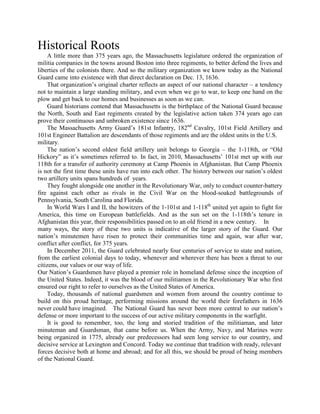Historical roots
- 1. Historical Roots A little more than 375 years ago, the Massachusetts legislature ordered the organization of militia companies in the towns around Boston into three regiments, to better defend the lives and liberties of the colonists there. And so the military organization we know today as the National Guard came into existence with that direct declaration on Dec. 13, 1636. That organizationâs original charter reflects an aspect of our national character â a tendency not to maintain a large standing military, and even when we go to war, to keep one hand on the plow and get back to our homes and businesses as soon as we can. Guard historians contend that Massachusetts is the birthplace of the National Guard because the North, South and East regiments created by the legislative action taken 374 years ago can prove their continuous and unbroken existence since 1636. The Massachusetts Army Guardâs 181st Infantry, 182nd Cavalry, 101st Field Artillery and 101st Engineer Battalion are descendants of those regiments and are the oldest units in the U.S. military. The nationâs second oldest field artillery unit belongs to Georgia â the 1-118th, or âOld Hickoryâ as itâs sometimes referred to. In fact, in 2010, Massachusettsâ 101st met up with our 118th for a transfer of authority ceremony at Camp Phoenix in Afghanistan. But Camp Phoenix is not the first time these units have run into each other. The history between our nationâs oldest two artillery units spans hundreds of years. They fought alongside one another in the Revolutionary War, only to conduct counter-battery fire against each other as rivals in the Civil War on the blood-soaked battlegrounds of Pennsylvania, South Carolina and Florida. In World Wars I and II, the howitzers of the 1-101st and 1-118th united yet again to fight for America, this time on European battlefields. And as the sun set on the 1-118thâs tenure in Afghanistan this year, their responsibilities passed on to an old friend in a new century. In many ways, the story of these two units is indicative of the larger story of the Guard. Our nationâs minutemen have risen to protect their communities time and again, war after war, conflict after conflict, for 375 years. In December 2011, the Guard celebrated nearly four centuries of service to state and nation, from the earliest colonial days to today, whenever and wherever there has been a threat to our citizens, our values or our way of life. Our Nationâs Guardsmen have played a premier role in homeland defense since the inception of the United States. Indeed, it was the blood of our militiamen in the Revolutionary War who first ensured our right to refer to ourselves as the United States of America. Today, thousands of national guardsmen and women from around the country continue to build on this proud heritage, performing missions around the world their forefathers in 1636 never could have imagined. The National Guard has never been more central to our nationâs defense or more important to the success of our active military components in the warfight. It is good to remember, too, the long and storied tradition of the militiaman, and later minuteman and Guardsman, that came before us. When the Army, Navy, and Marines were being organized in 1775, already our predecessors had seen long service to our country, and decisive service at Lexington and Concord. Today we continue that tradition with ready, relevant forces decisive both at home and abroad; and for all this, we should be proud of being members of the National Guard.
- 2. Although the countryâs growth and expansion has made the United States a large military force around the world, the National Guard still remains a community cornerstone âjust as did that when it was given birth in 1636. Yet the respect and gratitude shown to Citizen-Soldiers and Airmen by their communities has never been greater. Without the continued support of communities and employers, service members could not do what they do 24-hours a day, seven days a week as a central element of homeland defense. (Word Count 670)


